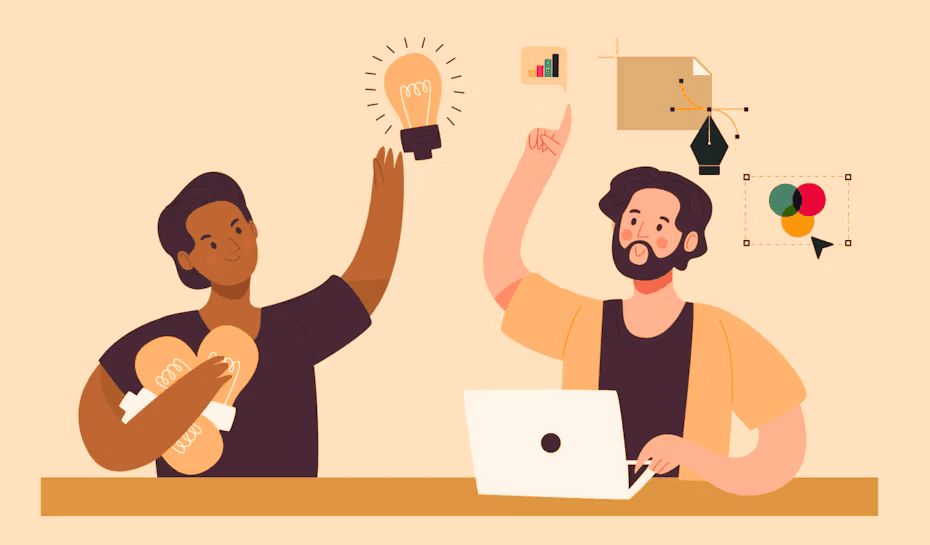Creative Director vs. Design Director: Key Differences for Recruiters
Published on November 1st, 2023
Recruiters and hirers often find themselves in a quandary when searching for top-tier talent in the world of design and creative leadership. Two titles that frequently come up are "Creative Director" and "Design Director." While both roles play a significant part in shaping a company's visual identity, they have distinct responsibilities and skill sets. In this SEO-friendly blog, we'll explore the nuances between a Creative Director and a Design Director and how recruiters can make informed decisions when hiring candidates for these roles.
Creative Director vs. Design Director: A Comparison
| Aspect | Creative Director | Design Director |
|---|---|---|
| Primary Focus | Strategic Vision and Branding | Visual Design and Aesthetics |
| Responsibilities | - Develop and implement creative strategies. - Oversee branding and messaging. - Guide creative teams in generating innovative ideas. - Maintain brand consistency. | - Lead design projects and ensure visual consistency. - Manage design teams and provide creative direction. - Develop and implement design strategies. - Focus on aesthetics and visual appeal. |
| Leadership Style | Visionary and Strategic | Detail-Oriented and Creative |
| Collaboration | Works closely with marketing, copywriting, and branding teams. | Collaborates with product managers, UI/UX designers, and other design specialists. |
| Experience Level | Typically requires more extensive experience in creative and strategic leadership. | Strong background in design and a deep understanding of aesthetics. |
| Industry | Common in marketing, advertising, and branding agencies. | Found in design-focused industries such as fashion, product design, and digital media. |
| KPIs | Success measured by brand growth, campaign success, and innovation. | Success measured by design aesthetics, user satisfaction, and visual consistency. |
| Communication Skills | Excellent verbal and written communication for conveying strategic vision. | Strong visual communication skills to guide design teams. |
| Innovation and Trends | Focus on innovation and staying ahead of market trends. | Emphasis on design trends, aesthetics, and user experience. |
| Adaptability | Must adapt to changing marketing landscapes and evolving brand identities | Must stay current with design tools, technologies, and aesthetic preferences. |
Key Differences
Now, let's delve into the key differences between a Creative Director and a Design Director:
Primary Focus: Creative Directors focus on the strategic vision and branding, while Design Directors prioritize visual design and aesthetics.
Responsibilities: Creative Directors develop creative strategies and maintain brand consistency. Design Directors lead design projects, manage design teams, and provide creative direction.
Leadership Style: Creative Directors are visionary and strategic, while Design Directors are detail-oriented and creative.
Collaboration: Creative Directors work closely with marketing and branding teams, while Design Directors collaborate with product managers and design specialists.
Experience Level: Creative Directors typically require more extensive experience in creative and strategic leadership, whereas Design Directors have a strong design background.
Industry: Creative Directors are common in marketing, advertising, and branding agencies, while Design Directors are found in design-focused industries like fashion and digital media.
KPIs: The success of Creative Directors is measured by brand growth and campaign success, whereas Design Directors are assessed based on design aesthetics and user satisfaction.
Communication Skills: Creative Directors need excellent verbal and written communication for conveying strategic vision, while Design Directors require strong visual communication skills to guide design teams.
Innovation and Trends: Creative Directors focus on innovation and staying ahead of market trends, whereas Design Directors emphasize design trends, aesthetics, and user experience.
Adaptability: Creative Directors must adapt to changing marketing landscapes and evolving brand identities, while Design Directors need to stay current with design tools, technologies, and aesthetic preferences.
Recruiters play a crucial role in finding the right creative or design leadership for their organizations. By understanding the key differences between a Creative Director and a Design Director, recruiters can better assess candidates and match them with roles that align with their strengths and expertise.
Both roles are vital for shaping a company's image and design direction, and choosing the right candidate for each role can make a significant impact on a company's success. Whether your company's focus is on branding and strategy or visual aesthetics and user experience, now you have a clear understanding of the distinctions between Creative Directors and Design Directors to help you make informed hiring decisions.
The roles and responsibilities of a Creative Director and a Design Director can vary depending on the organization and industry, but generally, they encompass the following:
Creative Director:
- Strategic Vision: Develop and communicate the creative vision for projects, campaigns, or brands.
- Team Leadership: Lead and inspire a team of designers, copywriters, and other creative professionals.
- Concept Development: Generate innovative ideas and concepts that align with project objectives and client needs.
- Client Collaboration: Work closely with clients to understand their goals and requirements, and present creative solutions.
- Quality Control: Ensure the quality and consistency of creative output across all projects and channels.
- Budget Management: Manage budgets and resources effectively to meet project goals within financial constraints.
- Trend Awareness: Stay updated on industry trends, emerging technologies, and creative best practices.
Design Director:
- Design Direction: Provide artistic direction and guidance to design teams, ensuring alignment with project objectives and brand guidelines.
- Team Management: Manage and mentor a team of designers, overseeing their work and providing feedback and support.
- Project Oversight: Oversee the design process from concept to completion, ensuring projects are delivered on time and within budget.
- Collaboration: Collaborate with other departments, such as marketing, product development, and engineering, to integrate design with overall project goals.
- Client Interaction: Engage with clients to understand their design needs and preferences, and present design solutions effectively.
- Quality Assurance: Ensure the quality and consistency of design deliverables, reviewing work for accuracy, creativity, and adherence to brand standards.
- Skill Development: Foster a culture of learning and development within the design team, encouraging skill enhancement and knowledge sharing.
Overall, both roles involve strategic leadership, creative direction, team management, and collaboration, but with different emphases based on the specific focus of each position.
Authors

Yash Chaudhari
With a strong background as an SEO and Content Specialist, Yash excels in driving organic traffic, improving search engine rankings, and creating SEO-optimized content. He has a proven track record of implementing strategies that increase website traffic and conversions. Additionally, Yash is an automotive enthusiast and has a keen interest in astronomy.
Hire the best without stress
Ask us how
Never Miss The Updates
We cover all recruitment, talent analytics, L&D, DEI, pre-employment, candidate screening, and hiring tools. Join our force & subscribe now!
Stay On Top Of Everything In HR

